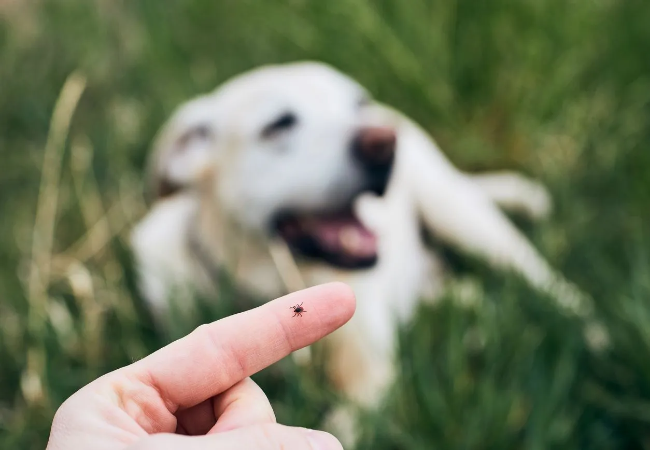Vet Approved Guide: 8 Things to Know About the Tick Life Cycle & How It Affects Your Pet (2025)🏊♂️🐶

In this article
Vet Approved Guide: 8 Things to Know About the Tick Life Cycle & How It Affects Your Pet (2025)🏊♂️🐶
By Dr. Duncan Houston BVSc
Ticks aren’t just a nuisance—they’re disease-spreading parasites with a complex life cycle designed to exploit warm-blooded hosts like your dog or cat. Understanding how ticks live, grow, and latch onto pets is essential to keeping your companions healthy. 🩺
As a veterinarian, I educate pet parents every season about tick risks, from Lyme disease to Rocky Mountain spotted fever. This guide breaks down the tick life cycle into 8 essential facts—and how to prevent trouble with help from Ask A Vet. 🐶🐱
1. 🥚 Ticks Start as Tiny Eggs (Thousands at a Time)
- 🧬 Adult female ticks lay thousands of eggs in grassy or wooded areas
- 🪵 Laid in soil, leaf litter, or brush—especially in spring and fall
Prevention tip: Avoid letting pets roam in overgrown or wooded areas during tick-heavy seasons. 🐾
2. 🐜 The Larval Stage: The First Tiny Biters
- 🐣 Larvae (seed ticks) hatch with six legs
- 🩸 They need their first blood meal to grow
- ⚠️ Even larvae can carry diseases picked up from small animals
They’re so small they often go unnoticed—especially on paws, faces, or ears. 👀
3. 🐞 Nymph Ticks: The Most Dangerous Stage
- 🕷️ After molting, larvae become 8-legged nymphs
- 📈 Nymphs are tiny but aggressive feeders—and most likely to spread disease
- ⚠️ Their bites often go undetected until symptoms appear
This stage is most active in late spring and early summer—protect your pet year-round. 🌿
4. 🕷️ Adult Ticks: The Most Visible and Persistent
- 🔍 Larger, easier to spot—especially after feeding
- 📅 Active in fall and early spring for many species
- 🧬 Females feed, mate, and lay eggs to restart the cycle
5. 🔄 The Tick Life Cycle Can Take Up to 3 Years
- 📆 Each stage depends on a successful blood meal
- 🌡️ Cold slows development, but they overwinter and return
Ticks don’t die off in winter—they wait for warmth to reactivate. ❄️
6. 🧪 Ticks Carry Multiple Diseases
- 🦠 Lyme disease (Borrelia burgdorferi)
- 🦠 Ehrlichiosis
- 🦠 Anaplasmosis
- 🦠 Babesiosis
- 🦠 Rocky Mountain spotted fever
📱 Use Ask A Vet if your pet shows symptoms: fever, joint pain, fatigue, or lameness. 🩺
7. 🧼 Removing Ticks Promptly Matters
- ⏳ Disease risk rises after 24–48 hours of attachment
- 🧷 Use tweezers or tick tools—grip close to the skin, pull straight
- 🧴 Clean the site and monitor for infection
8. 🛡️ Preventing Tick Bites Is Key
Recommended Products:
- 🧴 Oral or topical flea/tick preventives (e.g. NexGard, Frontline, Bravecto)
- 🦟 Tick-repelling collars (Seresto, Vet-recommended brands)
- 🌿 Natural repellents for mild-risk areas
Additional Tips:
- 🧹 Keep lawns trimmed and brush cleared
- 🚿 Check pets after hikes or outdoor play
📱 When to Use Ask A Vet
- 🩺 To identify a tick species or confirm safe removal
- 🤒 If symptoms of illness appear post-bite
- 🧾 For guidance on year-round tick prevention
✅ Final Thoughts: Know the Enemy, Beat the Bite
Understanding the tick life cycle helps you stay ahead of infestations and illness. With smart prevention, early detection, and support from Ask A Vet, you can enjoy the outdoors safely—tick-free. 🕷️🐾
Quick Recap:
- 🔄 Tick life cycle: egg → larva → nymph → adult
- 🦠 Nymphs pose highest disease risk
- 🛡️ Use year-round prevention and tick checks
- 📱 Call Ask A Vet for bites or illness
Need help this tick season? Visit AskAVet.com. 🐶






